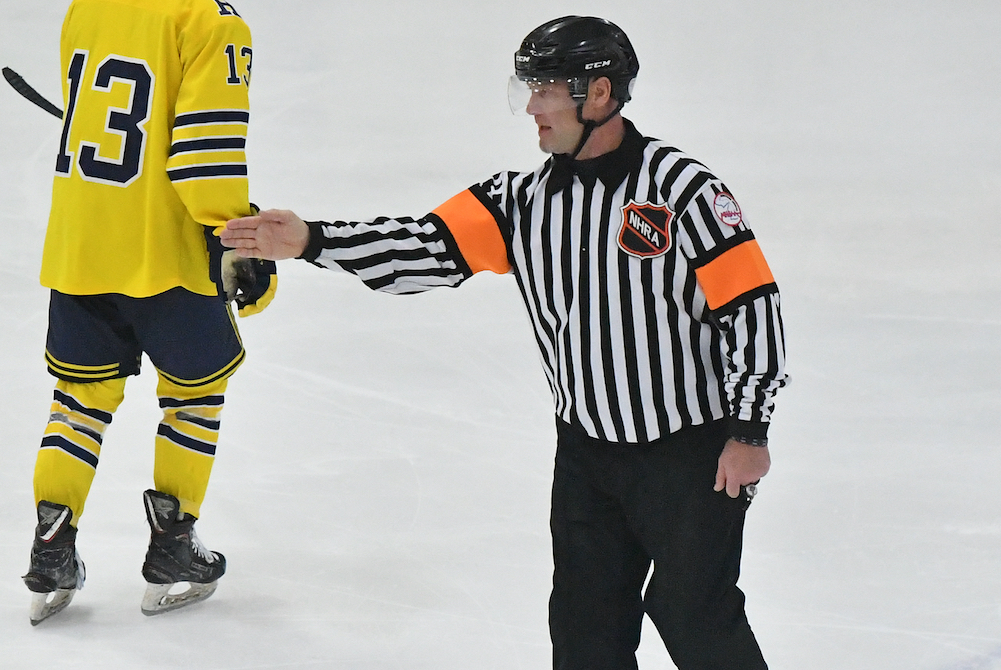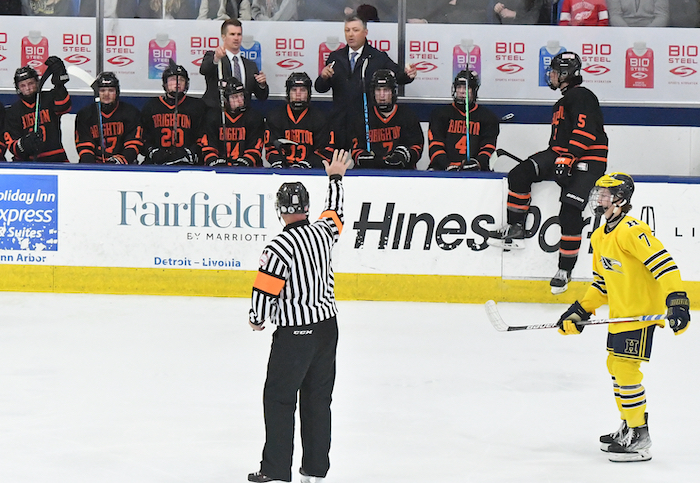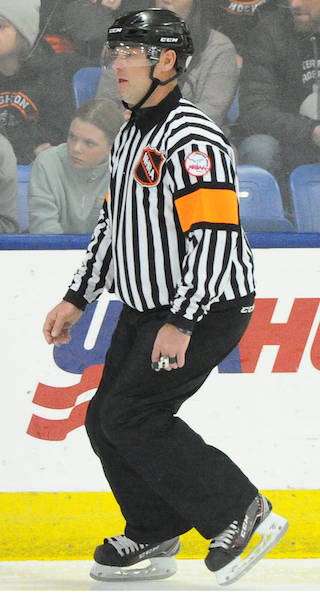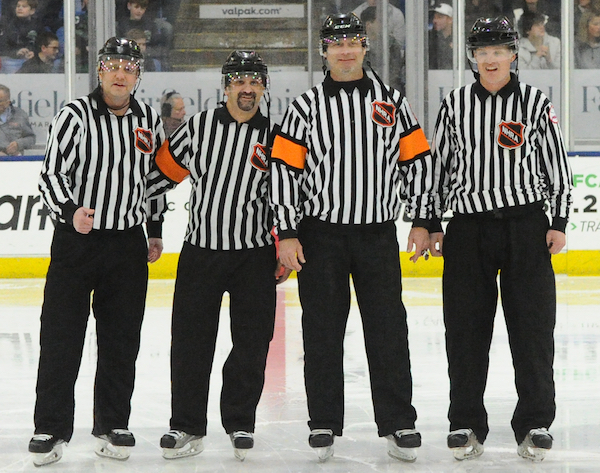
Injury in Past, Escanaba Standout Plays On
January 1, 2016
By Dennis Grall
Special for Second Half
ESCANABA – Speeding down the ice chasing a puck into the corner is just a routine part of hockey.
 Don't tell that to Dylan Gauthier of the Escanaba High School hockey team. He knows a lot can go wrong in just an instant as that skidding black sphere bounces along the ice.
Don't tell that to Dylan Gauthier of the Escanaba High School hockey team. He knows a lot can go wrong in just an instant as that skidding black sphere bounces along the ice.
As a freshman Feb. 7, 2013, in Chelsea, Gauthier was in hot puck pursuit when he was seriously injured in a freakish, non-contact incident that cost the three-sport athlete the rest of his hockey season. He suffered a broken right leg (tibia and fibula) and severed his right Achilles tendon when his skate hit a patch of ice and he ended up crashing into the boards.
"I was chasing a loose puck and I lost my edge and hit the boards (feet first)," Gauthier said Wednesday in his Soo Hill home shortly before the Eskymos would play Painesdale-Jeffers. "I hit the boards hard. I looked down and saw a hole in my leg. I knew something was wrong."
As he crashed into the boards, the blade on his left skate rammed into his right ankle and severed the Achilles tendon. "No one was there; I just kind of lost it," he said.
He instantly was in pain, "then I didn't feel anything. There was a lot of blood," he said, indicating he soon went into shock and his leg went numb, which was probably a blessing during an aftermath that eventually included a trip to the University of Michigan hospital in Ann Arbor.
"I was kind of out of it at first, but I knew it was bad," he said, recalling teammates would come to him and quickly leave once they saw the damage.
The mother of one of his teammates, T.J. Myrick, came onto the ice and wrapped the completely lacerated wound in her scarf in hopes of stopping the bleeding.
His parents, Mark and Mary, were home listening to the game on the radio and they quickly hit U.S. 2 and headed downstate at 9 p.m., a trip that took 10 hours thanks to a good blizzard. They were approaching the Mackinac Bridge about the time surgery began on the Achilles. Surgery on the broken bones took place a week later, with two screws inserted that will remain in his leg.
 Dylan recalls listening to the rest of the game broadcast in the hospital as he awaited surgery. The next day his teammates visited, but were allowed only in small groups and for a brief time. They gave him a hockey stick signed by each player and a team photo with the sister of a teammate, Jaylyn Dagenais, standing where he would have been.
Dylan recalls listening to the rest of the game broadcast in the hospital as he awaited surgery. The next day his teammates visited, but were allowed only in small groups and for a brief time. They gave him a hockey stick signed by each player and a team photo with the sister of a teammate, Jaylyn Dagenais, standing where he would have been.
He wasn't aware of the Achilles damage until reaching the hospital, and remembers thinking about what the athletic future held for him. "What happens next, what is the next step," he said, an indication that mentally he was in good spirits despite the major physical injuries.
After the surgery he learned the skate slice was very close to a major artery, which could have created even more serious damage.
Tim McCarthy, then in his final season as Escanaba head coach, said recently "when he went down I remember watching him on the ice, and he grabbed his leg right away. There was quite a bit of blood coming out, and we tried to get anything we could find to wrap his leg and stop the bleeding."
He said Gauthier's leg "snapped over the back of the skate and caught in there and wouldn't come out. There was nowhere to go but in (the tendon)."
McCarthy remembers that up until that injury Gauthier had exhibited typical freshman issues, noting, "Dylan was a little timid going into the corners. I had his cousin (Nick Vandermissen) pushing him to get more aggressive."
Gauthier, one of seven freshmen on that team, was on a line with Vandermissen and Levi Wunder, two of the best players in the program's 30-year history. "He was progressing well. He was starting to make strides. He always had talent, but he needed a mindset to go out and do what was asked of him and not be timid," said McCarthy.
"He is an athlete, and a good one. He is very good at what he does. He rebounded real well and works real hard."
McCarthy said it was fortunate the injury happened at the MPS Showcase, a huge midseason tournament, because it was so close to Ann Arbor. "They took care of him right away," he said.
The Eskymos handled the adversity very well, McCarthy said of winning two of the three weekend games: "We went down there to prove a point and try to get the respect we should have been getting. Nick had a tough time with it, but the team seemed more determined that weekend to do something for Dylan. They played a little harder after that."
 Matt Hughes, the current Escanaba head coach, said Gauthier "has responded pretty well to that freak injury. He is not letting it overtake him mentally. Being a young athlete, his body responded well and he was able to get back. The physical part was probably easier to overcome than the mental part, but it will always be in the back of your mind."
Matt Hughes, the current Escanaba head coach, said Gauthier "has responded pretty well to that freak injury. He is not letting it overtake him mentally. Being a young athlete, his body responded well and he was able to get back. The physical part was probably easier to overcome than the mental part, but it will always be in the back of your mind."
Gauthier missed the final 13 games of what became a school-record 24-4 season. He is in his fourth season on the varsity and helped the team reach the Division 2 Semifinals in 2014-15. "The kids are working hard. They want to get back to where we were at last year," said Hughes.
Gauthier has four goals and three assists this season as the Eskymos have built a 7-3 start. They return to Chelsea Jan. 28-30.
Gauthier also plays golf and football for the Eskymos. In fact, he was playing golf 82 days after the injury while wearing a brace and basically playing off one leg. Still, he earned second-team All-Upper Peninsula honors. He has been an all-U.P. first-team all-star the past two years and received some interest from college golf teams.
Golf is his favorite sport, which makes sense because his parents and brother Mark are also excellent golfers. Mark plays at Finlandia University in Hancock.
Playing golf that soon was difficult because it was hard to pivot on his right foot at first. He did not start running until shortly before football practice began, then returned as a running back for the junior varsity and scored three touchdowns against Gladstone.
He played on the varsity the last two years and noted that making cuts on the gridiron was the hardest part of his athletic recovery.
His mother has been pleased with how Dylan handled the injury and rehabilitation. "He has a laid-back attitude. That is why it didn't bother him," she said. "The whole thing affected us more than it did him."
He said, "mentally I was fine. I never thought about it out there (while playing any sport), but it was a little weird at first. I just blew it away. The chance of it happening again is kind of slim."
A fund-raiser directed by Bill LaMarch helped raise money for the team to purchase Kevlar socks, which go up to the knee and should prevent a skate from penetrating to the leg.
After the injury, Gauthier wore a long-leg cast with a window left open for the Achilles and was on crutches for a month, then had a boot cast. He did his rehab at Northwood Rehabilitation in Escanaba under the direction of physical therapist Marge Haslow. "She helped a lot, she got me through it all," he said. "She made you do your stuff. There were no easy days in there."
As his high school career begins winding down, Gauthier realizes he was very fortunate to come through such a freakish and serious injury with missing just over one month of his three-sport career.
"I've accomplished a lot. I know I could not have played at all," he said, relief obvious in his voice.
 Denny Grall retired in 2012 after 39 years at the Escanaba Daily Press and four at the Green Bay Press-Gazette, plus 15 months for WLST radio in Escanaba; he served as the Daily Press sports editor from 1970-80 and again from 1984-2012. Grall was inducted into the Upper Peninsula Sports Hall of Fame in 2002 and serves as its executive secretary. E-mail him at [email protected] with story ideas for the Upper Peninsula.
Denny Grall retired in 2012 after 39 years at the Escanaba Daily Press and four at the Green Bay Press-Gazette, plus 15 months for WLST radio in Escanaba; he served as the Daily Press sports editor from 1970-80 and again from 1984-2012. Grall was inducted into the Upper Peninsula Sports Hall of Fame in 2002 and serves as its executive secretary. E-mail him at [email protected] with story ideas for the Upper Peninsula.
PHOTOS: (Top) Escanaba's Dylan Gauthier controls the puck during his team's game against Painesdale-Jeffers on Wednesday. (Middle) Gauthier (2) suffered a painful injury during a game at Chelsea as a freshman in 2013 that required multiple surgeries. (Top photo and head shot by Dennis Grall; middle photo by Jack Hall.)

Retired NHL-er Back on Ice to Answer Call - By Making Them
By
Rob Kaminski
MHSAA benchmarks editor
March 16, 2023
The most accomplished skater on the ice during Friday’s triple-overtime MHSAA Division 1 Semifinal hockey thriller between Hartland and Brighton was not wearing the school colors of either team.
In front of a packed house at Plymouth’s USA Hockey Arena, referee Bryan Smolinski was in stripes, just like the rest of his officiating crew.
In his former life, he pulled on plenty of sweaters before lacing up the skates. That happens when one logs more than 1,000 games, tallies nearly 300 goals (274) and close to 400 assists (377) with eight teams spanning a 15-year playing career in the National Hockey League.
So, how did the 52-year-old former star player find himself on the ice last weekend as one of the referees for the pinnacle weekend of this high school season? Good question, even for the man known as “Smoke” during his playing days.
“I was working in youth development programs a few years back and reached out to some Michigan guys I had connections with about other ways to help the game,” Smolinski said. “I called Kevin May just to chat and asked, ‘Hey, how’s your reffing going?’ He said, ‘You know, we’re down a little bit,’ then said, ‘Why don’t you do it?’ I said, ‘Not a chance,’” Smolinski laughed.
Never Say Never
May persisted, imploring his friend to skate with him during a Fall league at Cranbrook in Bloomfield Hills. After eight weeks, once a week, Smolinski had a revelation.
“I’m like, ‘I’m kind of diggin’ this,’” Smolinski said “So, I did all the testing, and the educational part of it, and I really enjoyed it. I got with Danny (DiCristofaro) and his group, and he put me in as much as he could, and I really started to get my feet wet.”
 DiCristofaro is the assigner and referee-in-chief for the MHSAA’s Northeast Hockey Referees Association, and he has seen Smolinski’s growth first-hand.
DiCristofaro is the assigner and referee-in-chief for the MHSAA’s Northeast Hockey Referees Association, and he has seen Smolinski’s growth first-hand.
“Obviously he’s got great instincts and a feel for the game, along with a wealth of experience, all of which has allowed him to climb the ladder quickly,” said DiCristofaro. “It’s been a joy to watch his growth as an official.”
Fast forward to last Friday, and there were Smolinski and May sharing duties as referees during the MHSAA Semifinal with linesmen Michael Andrews and Thomas Robbins.
In between, there has been a learning curve that still continues, but the jump to officiating was not quite as daunting as his introduction to the NHL.
“I was scared to death. My first game was against Mario Lemieux. I’m in the old Boston Garden and now I’m playing against these guys and it’s their job, and they’re out there trying to make a living,” Smolinski recalled.
The emotions were not running nearly as frenzied for his first game as an MHSAA official, obviously, yet respect came in a different form.
“I couldn’t pick the puck up, I was breathing heavily; it was Kevin and me doing a two-man game in Brighton,” Smolinski recalled. “There were a few high-end kids playing, and I’m thinking, ‘I’m dying here.’ You know, there’s no training for that first time.”
What that experience did, however, was revitalize Smolinski in a new way. His playing career is well documented, not only in the NHL, but around Michigan. He enjoyed an honor-laden career at Michigan State University from 1989-93 before joining the Boston Bruins (who had drafted him three years earlier) at the end of the ’93 NHL campaign. Even after his final season, with Montreal in 2007-08, he stayed in the game via men’s leagues, or coaching his son, Max.
Smolinski and his wife, Julie, have three daughters: Ashtyn (22), Jojo (16) and Rylen (12), along with Max, whom dad coached for seven years including during a national championship run with a Little Caesars U15 team in 2019. Max, 19, is now playing collegiately at Rensselaer Polytechnic Institute.
So, for Smolinski, officiating offers a new chapter.
“Reffing brought back ... I wouldn’t say love of the game, because that’s always been there; it’s a different side of enjoying the game now. I have no horse in the race, my son’s off to college, my daughters are doing their thing; I wanted to find something new in the game,” Smolinski said. “I’ve coached, and I don’t want to do that. I found this, and I’ve stuck with it.”
Old College Ties
One of the great benefits of athletics at any level are the friendships made. For two kids who met in their first years on the MSU campus and forged a bond that lasts to this day, it’s amazing how their careers reached the pinnacle and have now come full circle.
Wes McCauley, an MSU teammate, is one of Smolinski’s best friends. After numerous years in the minor leagues, McCauley, like his friend, made it to the NHL. But McCauley made it as an official, working his first NHL game in 2003, when Smolinski was nearing the end of his playing career.
 Their games lined up on just a few occasions in the NHL, and the two lobbied hard to have McCauley work Smolinski’s 1,000th career game in his final season with the Canadiens in 2007-08. The request, sadly, was denied by the league.
Their games lined up on just a few occasions in the NHL, and the two lobbied hard to have McCauley work Smolinski’s 1,000th career game in his final season with the Canadiens in 2007-08. The request, sadly, was denied by the league.
On the rare occasions when the friends did share the same ice, less than a handful by Smolinski’s count, it was McCauley who was forced to rebuff any attempts at fraternization. It’s just part of an official’s edict.
“For both of us, it was amazing; it was just great,” Smolinski said. “I’d say, ‘Hey man what’s up?’ and he says, ‘Can’t talk.’ I’m like, ‘What do you mean, we talk all the time.’ Again, he’s like, ‘Can’t talk, get away from me.’ You know, it was just business.”
McCauley then reached the 1,000-game plateau himself in 2018 and is still going strong as a regular selection for playoff duties with nine Stanley Cup Finals assignments, including last year.
So, it should have been natural for Smolinski to go to his old friend immediately for officiating pointers once he joined the ranks, right? Well, maybe not immediately.
“I talk to Wes all the time, but I actually hid it from him right out of the gate because I didn’t want to take his razzing. Eventually it got out, and he was loving it. He started sending me whistles and visors and pants,” Smolinski said, grinning. “And none of it fit, you know, because I’m older and fatter, and he’s so damn skinny. So, I still had to go out and get all new gear.”
Both Sides Now
Having been to the top of his profession, now moving to the other side of that same mountain that his friend McCauley scaled, the respect has grown for those blowing the whistle.
“The preparation for officiating is much more mental,” Smolinski said. “Way more rules oriented. You’re always trying to get away with things that you can as a player; now you have to police that.”
Smolinski has a distinct advantage.
“I know everything they’re trying to do because I’ve done it. I know where you’re going with the puck, I know what kind of breakout you’re trying to do,” Smolinski said. “I have all the instincts, now I just try to stay out of the way and not ruin their game. The most fun is watching the game develop and the ups and downs. For me to be out there and enjoy it with them, that’s the fun part.”
 Those who have played hockey at any level have a built-in advantage should they consider the officiating avocation: the ability to skate. Unlike officiating in any other sport, skating is a prerequisite. This makes the pool limited, and almost solely composed of former players. Smolinski offers this advice.
Those who have played hockey at any level have a built-in advantage should they consider the officiating avocation: the ability to skate. Unlike officiating in any other sport, skating is a prerequisite. This makes the pool limited, and almost solely composed of former players. Smolinski offers this advice.
“I prefer sticking with high school because I think there’s more decorum, more administrative structure. Kids are playing for their schools, there’s loyalty there,” said Smolinski. “And there is more accountability. People need report to athletic directors and supervisors. Other levels can be more loosely governed, or a bit more maverick in nature. Moms and dads get involved more, coaches maybe know a little less,” said Smolinski.
He has, in fact, worked a handful of non-school games, and there’s a stark difference.
“I wanted to see what was going on, and I see it first-hand,” Smolinski said. “There are some crazy people and parents out there, and these guys are getting absolutely tortured. I’ve been tortured. There has to be a level of respect for what officials do. I think schools can rein that in a little more. All the guys I’ve met give up a lot of time and work hard because they love to do it and love the game.”
All sports need an assist from school administration and from those who once played the games to keep the officials recruitment moving in the right direction. People like Smolinski can help.
“He clearly doesn’t need to do this, and that’s what makes it so fantastic,” DiCristofaro said. “We need more people who have played – at any level – to do what he’s done and stay in the game as officials.”
Smolinski continues to promote the game in other ways as well. Currently, he is involved in the NHL’s Learn To Play initiative, which aims to inspire youth and welcome more families into the hockey community.
“We work hand-in-hand with the NHL Players Association for player development and industry growth,” Smolinski said. “Ages 5 to 9 are introduced to hockey, get head-to-toe gear and instruction, and meet some former players.”
The idea is to have fun first, which can translate into years and maybe even a lifetime in the sport. It’s a lifetime that has given Smolinski so much and continues to do so as he watches it unfold for others from his new vantage point.
PHOTOS (Top) MHSAA official Bryan Smolinski signals during Friday's Division 1 Semifinal between Brighton and Hartland. (2) Smolinski, a retired NHL standout, communicates with the Bulldogs' bench. (3) Smolinski keeps watch during game play. (4) Smolinski, third from left, with his crew: Michael Andrews, Kevin May and Thomas Robbins.

